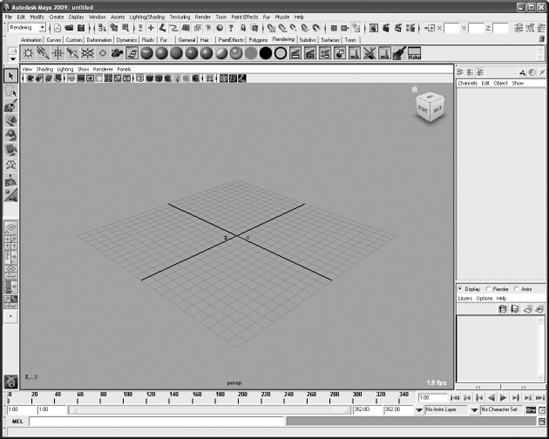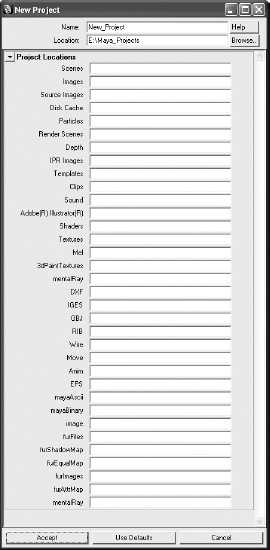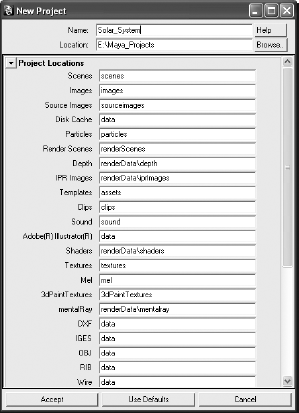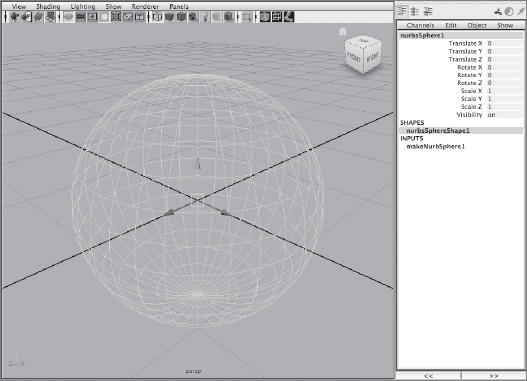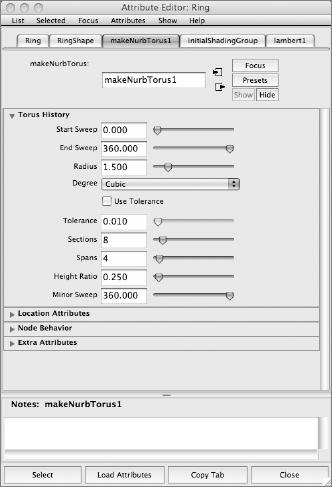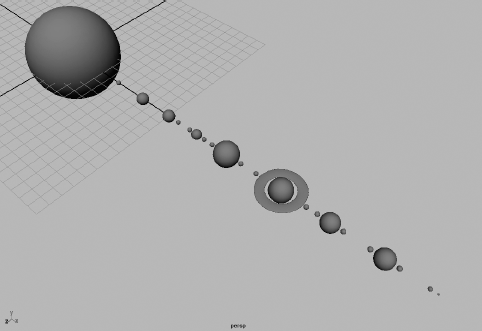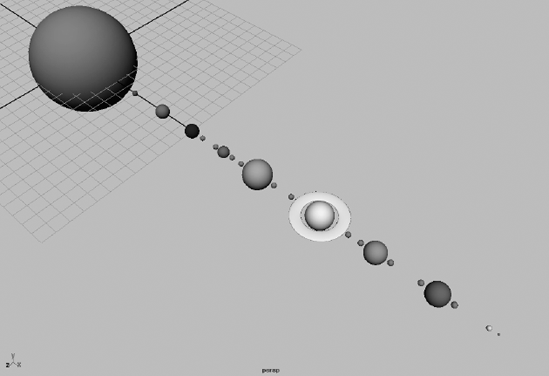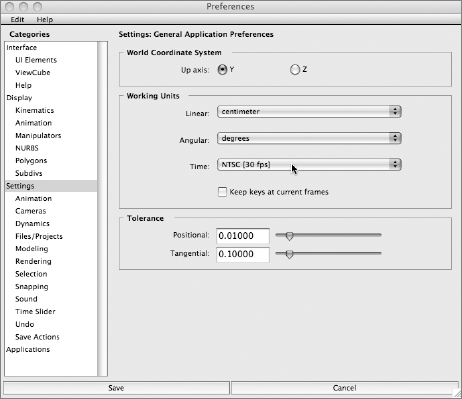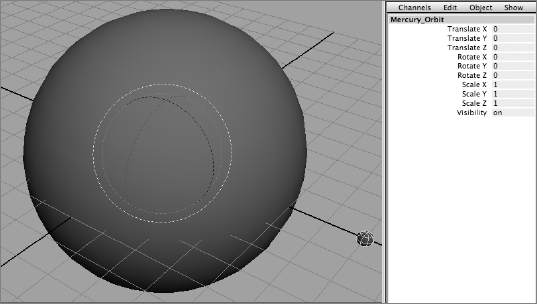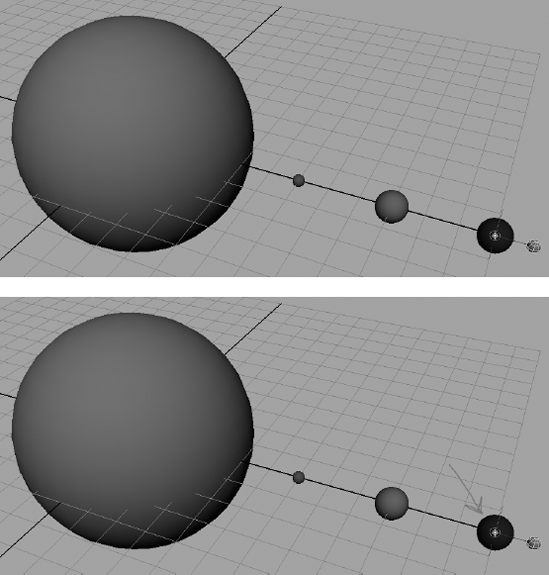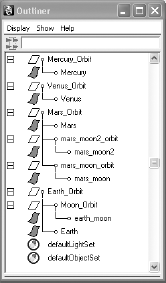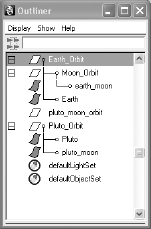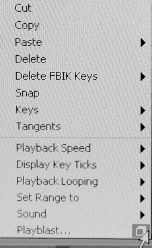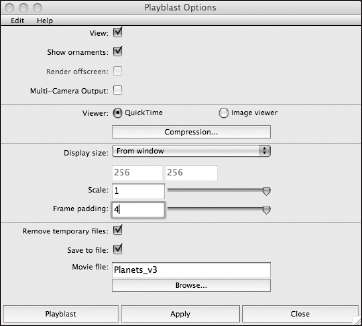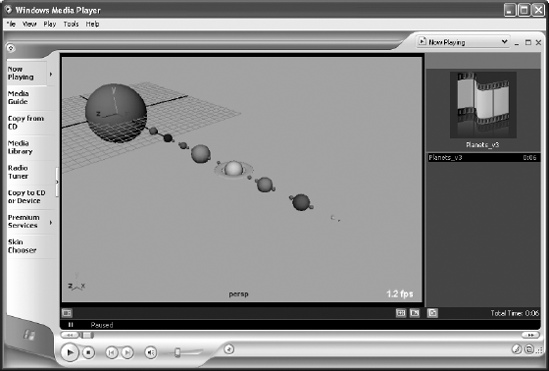In this chapter, you're going to start using Maya right away and get your groove on. This chapter will give you a quick primer on the Maya interface and let you experience tasks right away. The next chapter will show you more details and provide more explanations of how the entire Maya interface works and how some of the windows operate.
This chapter will take you through the creation of a Solar System project and the mechanics of animating orbits. With the Solar System exercise, you'll dive into creating simple objects, setting keyframes, and stacking your animation to get planets and moons to orbit each other and the Sun. This will expose you to object creation, simple modeling, object components, pivot point placement, grouping and hierarchies, basic keyframing, and timing.
Topics in this chapter include:
You Put the U in UI
Project Overview: The Solar System
The Preproduction Process: Planning
Creating a Project
The Production Process: Creating and Animating the Objects
Maya Object Structure
Using the Outliner
Outputting your Work
Fire up your computer, and let's get this project going. This section will introduce you to getting around the Maya User Interface (UI). It may seem difficult at first, but it will make sense as you move along. Once you get a hang of the interface by building the solar system, the next chapter will explain and create a reference for you of the entire interface.
You'll find everything you ever wanted to know about the interface and more in Chapter 3, "The Maya 2009 Interface." The overall goal of this chapter is to expose you to Maya UI basics as well as important scene creation and editing tools. You can consider the next chapter as a debriefing of sorts, to fill in UI details that are not covered in this chapter. If you prefer, you can skip ahead and get a more detailed rundown of the UI first and then return to this chapter for your first Maya project experience.
Let's get to the basics of how Maya is laid out (See Figure 2.1). Running across the top of the screen, right under the application's title bar, are the UI elements: Main Menu bar, the Status line, and the Shelf. On a Macintosh system running OS X, note that the Main Menu bar actually runs at the very top of the screen, above the application's title bar.
To the left of the screen, running vertically is the Tool Box, offering quick-view selections. Across from the Tool Box are the Channel Box/Layer Editor and sometimes the Attribute Editor (not displayed in Figure 2.1). Running horizontally at the bottom of the screen (from the top down) are the Time Slider, the Range Slider, the Character Set menu, the Auto Keyframe button, and the Animation Preferences button. In the middle of all these elements is the workspace, which is host to your panels (or Scene windows) and their menu options, (known as view s or viewports in some other 3D packages). This is where most of your focus will be; this is where you create and manipulate your 3D objects.
If you see a single, large view panel (most likely named persp), click inside it with the mouse to activate the panel and then press the spacebar to return to the four-panel layout shown in Figure 2.1. A panel is active when you see a blue borderline around it.
Maya is case sensitive in that it distinguishes between lowercase and uppercase letters. The conventions of this book will always print an uppercase letter to denote which key you must press, but will specify "Shift + the letter" when you must press the uppercase of that key. In other words, when we ask you to press the E key, for example, you should simply press the E key on your keyboard, lowercase. When an uppercase letter is called for, the book calls you to press Shift+E, requiring you to enter the uppercase letter E into Maya.
Maya requires the use of a three-button mouse, even on a Macintosh system. The clickable scroll wheel found on most mice can be used as the third button by pressing down to click with the wheel. The scroll wheel also lets you zoom into or out of a view panel.
In Maya, holding the Alt key on a PC or the Option key on a Mac along with the appropriate button (listed below) allows you to move in the view panel. The left mouse button (LMB) acts as the primary selection button and allows you to orbit around objects when used with the Alt key. The right mouse button (RMB) activates numerous shortcut menus and lets you zoom when used with the Alt key. The middle mouse button (MMB) used with the Alt key lets you move within the Maya interface panels, and the mouse's wheel can be used to zoom in and out as well.
Selecting objects in a view panel is as easy as clicking on them. If the object is displayed in Wireframe mode, its wireframe will turn green while it is selected. If the object is displayed in a Shaded mode, the object's wireframe will appear around the object. Shaded mode is a way of seeing your objects in the view panel with a basic surface, as opposed to a wireframe that you can see through. You'll see this as we do the following exercise.
To select multiple objects, simply hold the Shift key as you click on objects to add to your current selection. The previous selection's wireframe will turn white and the new selection will now be green. If you Ctrl+LMB (i.e., press the Ctrl key and click) on an active object, you will deselect it. To clear all of your current selections, click anywhere in the empty areas of the view panel.
When you select an object and enable one of the transformation tools (tools to allow you to move, rotate, or scale an object), you will see a Manipulator appear at or around the selected object. Figure 2.2 shows the three distinct and most common Manipulators for all objects in Maya: Move, Rotate, and Scale as well as the Universal Manipulator. You use these Manipulators to adjust attributes of the objects visually and in real time.
To activate a Transform tool, select an object and then click one of the Transform Tool icons from the Tool Box, shown in Figure 2.3.
Try This Let's put some of this into action, shall we?
Choose Create → NURBS Primitives → Sphere. Drag in a view panel anywhere on its grid to create a wireframe sphere, and then size it to your liking. In one of the view panels, press the 5 key on your keyboard, and the display of the sphere will become solid gray, as opposed to open wireframe. This is called Shaded mode. Press the 4 key to return to Wireframe mode.
With the sphere selected, select the Move tool
Red is for the X-axis, green is for the Y-axis, and blue is for the Z-axis. Cyan is for free movement in both axes of the active panel view.
Clicking any one of the three arrows lets you move the object only on that particular axis. The square in the middle of the Manipulator lets you move the object freely about the plane of the view panel, regardless of the axis. When you select a Manipulator handle for movement, it turns yellow. The Free Movement box in the center then turns back to its regular color, cyan.
Next, select the Rotate tool
Now try selecting the Scale tool
Try selecting the Universal Manipulator
Go ahead and click around the interface some more. Create more primitive objects and tool around a bit. Move around the view panels and see how it feels. Give the tires a good kick. Enough chatting—let's jump into the Solar System project.
This project focuses on familiarizing you with the fundamentals of navigating Maya, object creation, hierarchy, and pivots, all of which are important concepts for scene manipulation and animation within Maya. In this exercise, you will create and animate a simple simulation of our working solar system. (You may have done this in school using coat hanger wire and Styrofoam balls.) This time-tested tutorial is great practice for getting used to object creation, hierarchies, scene manipulation, UI navigation, and working with objects and selections. It will show you how to set up hierarchies and give you experience in working with the proper nodes within a group to create hierarchically layered animation.
Every smooth operation begins with a good plan. The more research and focused information you gather, the better off you'll be in your work. For this exercise, you'll need to find out where each of the planets is in relation to the Sun and to each other and also how many moons they have.
Starting with the Sun in the center, the planets in order are Mercury, Venus, Earth, Mars, Jupiter, Saturn, Uranus, Neptune, and Pluto. (We'll label Pluto a planet for old time's sake, even though it was reclassified as a "dwarf planet" by the scientific community in 2006.) All these planets actually orbit the Sun in ellipses, but we'll give them circular orbits for this exercise. Most planets have a number of moons that orbit them, and one, Saturn, has large rings that circle around it.
Earth | 1 moon |
Mars | 2 small moons |
Jupiter | 16+ moons |
Saturn | 3 large rings and 18+ moons |
Uranus | 18 moons |
Neptune | 8 moons |
Pluto | 1 moon |
Creating and animating all those objects may seem overwhelming, but it's a great way to become comfortable with Maya and animation. Because the goal of the project is achievable without making every moon, you'll cut most of them out of your scene and make a maximum of two moons per planet.
You can redo this exercise in more detail when you feel more comfortable with Maya. For instance, if, after you've worked through the exercises in this book you feel like creating a much more accurate solar system with beautifully textured planets and a perfect starry backdrop, go for it! It will still be a good idea to set up and animate the scene carefully, just as you did (or should have done) the first time you worked on this exercise.
The more you run this exercise, the clearer Maya's scene manipulation and hierarchy structure will become to you. Art is a marriage of inspiration, hard work, and practice.
Projects are Maya's way of managing a scene's assets; a file and folder structure that keeps your files organized according to projects. We'll have a project for the Solar System exercise.
Start by creating a new project for this assignment. Choose File → Project → New to open the New Project window. (Figure 2.4 shows the Windows version; the Mac OS X version has the same fields.) Files are organized in a particular way in Maya. The top level of this organization is the Project folder. Within the Project folder are numerous file folders that hold your files. The two most important types are the Scenes and Images folders. The Scenes folder stores your scene files, which contain all the information for your scene. The Images folder stores images you've rendered out from your scene. As with clothing and other items around your house, keeping your files and projects organized is a good practice.
Note
The scene files discussed in this chapter are included on the CD in a project layout explained in the following text. copy the scene files on the CD for this project into your own project folders once you create the project.
To create a new project, follow these steps:
In the Name field in the New Project window, enter Solar_System as the name for your project. In the Location box, type the location where you want to store your projects.
The default location for Windows XP is
My Documentsmayaprojects; for Macs, the default location isHome (/Users/<yourname>)in the Documents/maya/projects/default folder. If you prefer, you can put projects in a folder on a secondary or external hard drive to keep them separate from your operating system; this allows for easier backup and is generally a safer environment.If you are using a Windows system, create a folder on your hard drive called Projects using Windows Explorer. If you are using a Mac, select a drive in the Finder and create a folder on the drive called Projects. In the New Project window, click the Browse button and select
D:Projects(Windows) or<Hard Drive Name>/Projects(Mac) for the location. Maya will fill in all the other fields for you with defaults; just click the Use Defaults button. Click Accept to create the necessary folders in your specified location. Figure 2.5 shows the completed New Project window in Windows; except for the drive name, the values are the same on a Macintosh.
How much disk space you require depends on the project and the complexity and extent of your models and animation. At this stage of the game, your scene files will typically be small. You'll need about 10 to 15MB of free space for this project.
You'll start to consume serious disk space when you render out hundreds of frames at a time. After you create projects, you can switch between them by choosing File → Project → Set and selecting the new project. Maya will then use that project's folders until you switch to or create another project. You may also select a recent project by choosing File → Recent Projects. Maya by default will list four of your recent projects and scene files on the File menu for easy access.
As discussed in Chapter 1, "Introduction to Computer Graphics and 3D," production is typically divided into phases to make workflow easier to manage. In this project, you'll first create the Sun, the planets, and their moons; then you'll animate their respective orbits and rotations.
The first thing we're going to do is create the Sun and the planets. Follow these steps:
Choose File → New Scene (or press Ctrl+N). Maya will ask if you want to save your current scene. Save the file if you need to, or click Don't Save to discard the scene.
By default, Maya's screen should begin in an expanded perspective view. Press the spacebar to enable the four-panel view. Once you are in the four-panel view, press the spacebar with the cursor inside the top view panel to select and maximize it.
To create the Sun, you will need a primitive sphere. A primitive is a basic 3D shape. First, let's turn off a Maya feature called "Interactive Creation" that is on by default. Turning off Interactive Creation allows you to create the sphere at the center of the grid (the origin) without having to click and drag its size and then reposition it manually. Uncheck Create → NURBS Primitives → Interactive Creation to toggle it off as shown in Figure 2.6. For more on how to create primitives with interactive feedback, see the section on primitives in Chapter 3.
With Interactive Creation turned off, choose Create → NURBS Primitives → Sphere. This will place a NURBS sphere exactly at the origin—that is, at a position of 0, 0, 0 for X,Y,Z. This is good, because the origin of the workspace will be the center of the solar system too.
Select the word nurbsSphere1 in the Channel box to the right of the Maya UI (shown in Figure 2.7), and enter Sun to rename it. If you don't see the Channel box in your Maya window, please refer to section on the Channel box in Chapter 3.
Naming your objects right after creation is a good habit to develop. Doing so makes for a cleaner scene file and a more organized workspace. This is particularly important if anyone needs to alter your scene file; proper naming will keep them from getting frustrated when they work on your scene.
Note
Maya typically uses an object-naming structure called a humpback style, where words are slung together without spaces. The first letter of a new word in the humpback name is capitalized instead. An example of humpback style is the name indoorPatioScene. Maya uses this structure when naming nodes, such as the node name nurbsSphere1.
Choose the Scale tool in the Tool Box to activate the Scale Manipulator and uniformly scale the Sun sphere up to about four times its creation scale of 1. (Make it a scale of about 4 in all three axes.) For more precision, you can

Once you enter the final value through either method, press Enter and the sphere will grow to be four times its original size (at a scale of 1). Once you enter the values in either the Channel box or the Input box, a scale of 4 will appear in all three fields, as shown in Figure 2.8, and your Sun will expand in size by a factor of 4. Entering exact values in the Channel box or Input box is a way to scale the sphere precisely; using the Manipulator is not as precise.
Next, you will create the primitive spheres you will be using for the planets. Leave Interactive Creation off, and follow these steps:
Create a NURBS sphere for Mercury and name it Mercury, just as you did before by choosing Create → NURBS Primitives → Sphere. A new sphere appears at the origin. Click its name in the Channel box, and change it to Mercury.
Choose the Move tool from the Tool Box to activate the Move Manipulator, and move Mercury a few grid units away from the Sun in the positive X direction. (Click the red arrow and drag it to the right.) Leave about two grid units between Mercury and the Sun.
Because Mercury is the second smallest planet and is tiny compared to the Sun, scale it down to 1/20 the size of the Sun, or type in 0.2 in all three axes of scale if you choose to enter the values manually in the Channel box.
Repeat steps 1 through 3 to create the rest of the planets and line them up, placing each one farther out along the X-axis. Be sure to keep about two grid units of space between each of them. Scale each one proportionally as follows:
Venus | 0.5 |
Earth | 0.5 |
Mars | 0.4 |
Jupiter | 1.0 |
Saturn | 0.9 |
Uranus | 0.7 |
Neptune | 0.7 |
Pluto | 0.15 |
These proportions are not exactly the same as those found in the real solar system, but they will do nicely here. Figure 2.9 shows how your solar system should look now.
Note
No, Pluto is not actually a planet, but for nostalgia's sake, we'll include it here in our solar system.
Now is the perfect time to start using snaps. Some common snap icons are shown in Table 2.1. Snap icons are explained in greater depth in the next chapter. These icons run across the top of the UI just below the Main Menu bar, as shown here.
You use snaps to snap objects into place with precision, by placing them by their pivot points directly onto grid points, onto other object pivots, onto curve points, and so on. Here you will reposition all the planets slightly to center them on the nearest grid line intersection. To do so, follow these steps:
Select the first planet, Mercury; choose the Move tool from the Tool Box; and toggle on grid snaps by clicking the Snap to Grids icon

The center of the Move Manipulator turns from a square to a circle, signaling that some form of snapping is active. Grab the Manipulator in the middle by this circle, and move it slightly to the left or right to snap it onto the closest grid intersection on the X-axis.
Select the remaining planets, and snap them all to the closest grid intersection on the X-axis, making sure to keep about two grid spaces between each of them. Because the Sun was created at the origin and you haven't moved it, you don't need to snap it onto an intersection.
Now create the ring for Saturn. To do so, follow these steps:
Choose Create → NURBS Primitives → Torus to get a donut shape placed at the origin. Remember, Interactive Creation is turned off. You can also try creating the torus with the Interactive Creation option. In that case, click and drag the mouse to create the donut shape as you prefer. Once you have a ring, use the Move tool to snap it to the same grid intersection as Saturn. This will ensure that both the planet and its ring are on the same pivot point and share the same center.
Select the torus shape you've created, and name it Ring (if you haven't already done so) in the Channel box.
While the torus shape is still selected in the top view, press the spacebar to display the four-panel layout. Place the mouse cursor in the persp view and press spacebar to maximize the Perspective window.
Press the F key to focus the perspective display on the ring, and on Saturn as well. Pressing F will center and zoom in the panel on just the selected object(s).
Press 5 to get into Shaded mode and, with the torus selected, press 3 to increase the resolution display for the ring. Display resolutions are achieved by pressing the 1, 2, or 3 keys and are further explained in the next chapter. Pressing 3 will give you the smoothest view of the torus in the view panels. That's a good thing.
From the Tool box, select the Scale tool, and scale the torus down to 0 or close to 0 in the Y-axis (the torus' height in this case) to flatten it down.
You'll notice that the ring is too fat and is cutting into the planet. You need to edit the attributes of the ring to increase the inside radius of the donut shape and create a gap between the planet and the ring.
Press Ctrl+A (Ctrl+A will also work on a Mac) to open the Attribute Editor, and then click the makeNurbTorus1 tab to select its creation node. (See Figure 2.10.)
Increase the Radius attribute to about 1.5, and decrease the Height Ratio attribute to about 0.25 to get the desired effect.
Now all your planets are complete, and you can move on to the moons.
Now save your work, unless you like to live on the edge. Saving frequently is a critical habit to develop. Power failures and other unforeseen circumstances (such as your pet jumping onto your keyboard) may not happen often, but they do happen, and usually just at the wrong time. (As mentioned in the sidebar "Saving Multiple Versions of Your Work and Incremental Saving," Maya's Incremental Save feature makes it easy to maintain backups of your work.) Because you created this as a new project, the Save File window will direct you to the Scenes folder of that project. Save your scene as planets in the .mb (Maya Binary) format. (If you're working in Maya PLE, you can only save your files as .mp files, which may not be compatible with full versions of Maya 2009. Maya PLE saves scenes as .mp files simply to differentiate them from full Maya-version saved files.)
The file Planets_v1.mb in the Scenes folder of the Solar_System project on the CD shows what the scene should look like at this point.
For the planets with moons, create a new NURBS sphere for each moon. For simplicity's sake, create a maximum of only two moons for any planet. However, feel free to make all the moons for all the planets once you get a handle on this exercise.
The first moon will be the Earth's. Use the top view to follow these steps:
Create a NURBS sphere and scale it to about half the size of Earth using the Scale tool. Just visually estimate the size of the moon.
Move the sphere to within half a unit of Earth using the Move tool by the X-axis. There's no need to snap it to a grid point, so toggle off the Snap to Grids icon

Repeat steps 1 and 2 for the remaining moons, placing them each within half a grid unit from their respective planets. When placing two moons, place them on opposite sides of the planet.
Once you're done with all the moons, their placements, and sizes, select all the elements in the scene and press 3 to increase the display resolution on all the spheres. This gives you a smoother view of the NURBS spheres. When you're done, you should have a scene similar to Figure 2.11 in perspective view. If you don't, it's clear Maya doesn't like you.
To help distinguish one gray planet from another, attach simple shaders to each of the planets to give them color. You can easily take care of this task using the Hypershade window. Follow these steps:
Choose Window → Rendering Editors → Hypershade to open the Hypershade window. This window lists and allows you to edit all the shaders and textures in the scene. With this window, you create the look of your objects by assigning colors, surface properties, and so on. You will notice three default (or initial) shader icons already loaded. (See Figure 2.12.) For more on the Hypershade window, See Chapter 3.
In the Create Maya Nodes panel on the left of the Hypershade window and under the Surface heading, click the Lambert icon (a gray sphere) to create a new Lambert shader node. It will appear in the top and bottom of the Hypershade window. Click it another eight times to create a total of nine Lambert shading groups in the Hypershade window.
Click the first of the new Lambert nodes (lambert2) in the Hypershade window, and then double-click its icon to open the Attribute Editor. At the top, replace lambert2 with Mercury_Color to identify this material as the one you will use for Mercury.
Name each of the remaining planets in your animation (Venus, Earth, Mars, Jupiter, Saturn, Uranus, Neptune, and Pluto).
Note
To rename a node in the Hypershade window, you can also right-click the node's icon and choose Rename from the shortcut menu that appears.
Again, keeping a well-named and organized scene is critical to a smooth animation experience. It's so much more of a chore to root through dozens of unnamed nodes to find the one you want. When you've finished naming all the material nodes, save your work.
Once you've created the shaders, you can assign the appropriate colors to each of them according to the planet they represent.
Double-click Mercury to open its Attribute Editor if it's not currently open (See Figure 2.13).
To change the color of the shader, click the gray box next to the Color attribute. This opens the Color Chooser window, from which you can choose a new color from the color wheel or by adjusting values with the HSV sliders. Because Mercury has a brownish red appearance, go with an orange color, such as in Figure 2.14 (take note of the HSV values).
Change the remainder of the shaders as follows:
Mercury
Orange Brown
Venus
Beige Yellow
Earth
Blue
Mars
Red Orange
Jupiter
Yellow Green
Saturn
Pale Yellow
Uranus
Cyan
Neptune
Aqua Blue
Pluto
Bright Gray
Figure 2.15 shows the shading groups.
Next you will apply shaders to each of the planets. Select a planet in the Perspective window and right-click its corresponding material in the Hypershade window to open a marking menu. Drag up to highlight Assign Material to Selection, and release the button to select it. You can also use the middle mouse button to drag the material from the Hypershade window to its planet. Leave the moons set to the default gray color. When you're finished, you should have a scene similar to Figure 2.16.
Now that you're done, you're ready to animate. Just save this file and, if you've enabled Incremental Save as recommended earlier, your file won't be replaced with subsequent saves. This way, if you get lost in your animation and need to start fresh, you won't have to re-create everything from scratch. You can just return to a previous version of the file and start your animation over.
To begin this phase of the project, load the file Planets_v2.mb in the Scenes folder of the Solar_System project on the CD to your hard drive, or continue with your own scene file.
The animation you'll be doing for the orbits is straightforward. You will rotate the planets around their own axes for their self-rotation, then you'll animate the moons around the planets for their lunar orbits, and finally you'll make the planets and their moons orbit the Sun.
The premise of this exercise deals with hierarchy and pivot points. A pivot point is an object's center of balance of sorts. Every object or node that is created in Maya has a pivot point set at the origin. Because most objects, such as the spheres you created for the planets, will appear at the origin upon creation, their pivot points are automatically centered.
Once you move an object, as you have done to position the planets and moons, the pivot point moves with it. Therefore, all your planets' and moons' pivot points will already be correctly positioned at the center of each planet and moon.
Now you need to set up your scene file's animation settings:
Press F2 to open the Animation menu set. Menu sets are groupings of menu headings in the Main Menu bar. They are organized according to the type of task at hand. You will see the first several menu headings change when you switch from one menu set to another.
At the bottom of the UI, you will notice a slider bar (the Range slider) directly below the strip of numbers counting off the frames (the Time slider) in the scene. Using the Range slider, you will set the length of your animation to go from 1 to 240. Enter 1 for the Scene Start Frame and Range Start Frame boxes (Figure 2.17). Enter a value of 240 for the Scene End Frame and Range End Frame boxes, also as called out in Figure 2.17.
To the right of the Range slider, click the Animation Preferences icon (


Also verify that Up axis is set to Y and not Z, as shown in Figure 2.18. This ensures that you have designated the Y-axis to be pointing "up" in the perspective window or pointing out at you from the monitor in the top view. "Y up," as it's called, is Maya's default, but it never hurts to make sure, especially if you are on a shared computer.
Note
Choose Window → Settings/Preferences → Preferences to open the Preferences window. Under Settings: Undo, make sure Undo is on (if it isn't already), and set Queue to Infinite. Setting Queue to Infinite takes a little more system memory, but it's worth it. With this configuration, you can undo (press Ctrl+Z; Command+Z, or just Z if you are using a Mac) as many times as it takes to undo any blunders. To close the Preferences window, click Save.
Now you're ready to animate Mercury's rotation. Follow these steps:
Select Mercury first, and press E to activate the Rotate tool. The E key is the hotkey to invoke the Rotate tool in Maya and is the same as if you clicked the Rotate Tool icon in the Tool Box as you have been doing so far. Press F to focus on it in the perspective view, or zoom in on it manually.
Make sure you are on frame 1 of your animation range by clicking and dragging the Scrub bar (refer to Figure 2.17) to place it at the desired frame. You can also manually type in the frame value of 1 in the Current Frame box.
For Mercury, you'll be setting your initial keyframe for the Y-axis rotation. Click the Rotate Y's attribute name in the Channel box to select it (it is then highlighted in gray as shown in Figure 2.19) and, in the Main Menu bar, choose Animate → Set Key. This places a keyframe for a rotation of 0 in the Y-axis at frame 1 for the Mercury sphere. If you followed the advice in the sidebar "Setting Keyframes," earlier in this chapter, only the Rotate Y's attribute Value box will turn from white to orange to indicate a keyframe exists for that attribute. If you left the Set Key command at its defaults, choosing Animate → Set Key will set keys on all the attributes for the sphere, turning all their values orange in the Channel box.
Using the Scrub bar in the Time slider, go to frame 240. Grab the Rotation Manipulator handle by the Y-axis (the green circle), and turn it clockwise a few times to rotate the sphere clockwise. You'll notice you can rotate the object only so far in one direction before it seems to reset back to its original starting rotation. Rotate it as much as it will go, and release the mouse button. Then click on the Manipulator again and drag to rotate it as many times as necessary until you are satisfied.
Choose Animate → Set Key with the Rotate Y attribute still selected in the Channel box. This will set a keyframe for the new Y-axis rotation at frame 240 for the Mercury sphere.
To playback your animation, you can scrub your Time slider. Scrubbing is using the mouse to move the Scrub bar back and forth so you can watch the animation play back in a window. Click in the Time slider on the Scrub bar, hold down the left mouse button, and move your cursor side to side to scrub in real time. You'll see Mercury rotating around itself in your active view panel if you set your two keyframes as described.
Clicking so many things just to set two keyframes may seem like a lot of work, but you're doing this the long way right now; you're not yet using any shortcuts or hot keys. You'll start using those for the next planet.
You have the self-rotation for Mercury worked out. Mercury has no moon, so let's get Mercury orbiting the Sun.
You've learned that every object created in Maya is created with a pivot point around which it rotates, from which or to which it scales, and which acts as the placement point for its X-, Y-, and Z-coordinates. Now, to orbit Mercury around the Sun, the sphere must rotate around a pivot point that is placed in the middle of the Sun. If the pivot point for Mercury is already at the center of itself, how can you rotate it around the Sun?
One idea is to move its current pivot point from the center of itself to the center of the Sun. That would, however, negate Mercury's own rotation and it would no longer spin around its own center, so you can't do that. You need to create a new pivot point for this object. This way you have the original pivot point at Mercury's own center so it can self-rotate, and you have a second pivot point at the Sun so that Mercury can rotate around that point around the Sun. We will accomplish this by creating a new parent node above Mercury in the hierarchy. Now what does that mean?
In order not to get too confusing, we will take the time in the following section to introduce the concept of Maya object structure: nodes and hierarchies. Save your progress so far and open a new blank scene. After this explanation, we will resume the Solar System exercise.
Let's take a time out from the Solar System exercise and take a look at how objects and hierarchies work in Maya. On top of everything that you see in Maya—its interface—there is a layer that you don't see: the code. The layer of code keeps the objects in Maya organized through a network of nodes. How you relate these nodes defines how you've built your scene. In short, using Maya is essentially programming your computer directly to create 3D objects and animation.
So, having a solid understanding of how Maya defines objects and how they interact is essential to an efficient and successful animation process. This involves getting an intrinsic understanding of how nodes relate, whether it's a straightforward parent-child hierarchy in which one affects the other directly or a more complicated script-driven expression connecting 15 attributes of several objects to simplify a task.
At its core, Maya relies on packets of information called nodes, and each node carries with it a group of attributes that in combination define an object. These attributes can be spatial coordinates, geometric descriptors, color values, and so on. Taken together, an object's attributes define it and how it animates. You can define, animate, and interconnect any or all of these attributes individually or in concert, which gives you amazing control over a scene.
When you're beginning to work with a robust program, the learning curve occasionally spikes. With Maya, these spikes typically involve nodes and their interconnections. Although the interface automates much of the node creation and relationship process, the sooner you are exposed to the implications of the node level of objects, the easier it will be for you to overcome the typical learning curve. Even though you may not actively see that you're making root-level connections between nodes and attributes, that is exactly what you are doing every time you click a command.
Nodes that define the shape of a surface or a primitive are called creation nodes or shape nodes. These nodes carry the information that defines how that object is created. For example, a sphere's creation node has an attribute for its radius. Changing that attribute changes the radius of the sphere at its base level. Shape nodes are low on the hierarchy chain and are always child nodes of transform nodes. The sphere listens to its creation node attributes first and then moves down the chain to its other nodes' attributes (such as position, rotation, or scale).
Note
Not all primitives are created with shape nodes, so changes at the creation level may not be possible on certain objects; some objects are created without a creation node. When you create a new primitive or an object, make sure the History button (
The most visible and used nodes are the transform nodes, also known as DAG nodes. These nodes contain all the transformation attributes for an object or a group of objects below it. Transformations are the values for translation (position), rotation, and scale. These nodes also hold hierarchy information on any other children or parent nodes to which they are attached. When you move or scale an object, you adjust attributes in this node.
Try This As an example of working with transform nodes, you can create a sphere and see what happens in the Attribute Editor as you adjust its position and size. Follow these steps in a new Maya scene:
Press Ctrl+A to open the Attribute Editor. (Ctrl will function the same on a Mac as on a PC, so Mac users can also use their Ctrl key when called for in the text).
The tabs along the top of the window let you switch between the nodes that are attached to this object. The current tab should be on the sphere's shape node called nurbsSphereShape1. This node contains specific information about the object, but it is not typically a node that you edit.
Press W to select the Translate tool. With the sphere still selected, click the nurbsSphere1 tab in the Attribute Editor to access the sphere's transforms node. Move the sphere a little bit in the X direction. Notice in the Attribute Editor that the Translate attribute for X has changed. You should also see the change in the Channel box.
Press R to select the Scale tool. R is the hotkey by default in Maya for the Scale tool and is the same as clicking the Scale tool icon in the Tool box (

In the creation node of makeNurbsSphere1, change the radius from 1.0 to 2.0. The sphere doubles in size because its radius is doubled. Switch back to the transform node (nurbsSphere1) and take note that the Scale X, Scale Y, and Scale Z attribute values are unchanged. This is because you affected the size of the sphere through its Radius attribute in the creation node at its root level, not through the Scale attributes in a higher node. Any changes you make to the Scale attributes take effect after changes in the lower node. This is a perfect example of how one node's output (here, the Radius attribute) changes another node.
A parent node is simply a node that passes its transformations down the hierarchy chain to its children. A child node inherits the transforms of all the parents above it. So by using hierarchies for the Solar System exercise, you will create a nested hierarchy of parents and children to animate the orbital rotation of the nine planets and some of their moons.
By creating parent-child relationships, you can easily animate the orbit of a moon around a planet while the planet orbits the Sun. With the proper hierarchy, the animation of the planet orbiting the Sun automatically translates into the moon. In effect, the planet takes the moon with it as it goes around the Sun.
Child nodes have their own transformations that can be coupled with any inherited transforms from their parent, and these transformations affect them and any of their children down the line.
The rotation of one of the planets around the Sun takes into account its moons, but those moons can have their own animation to spin themselves around their planets. You are about to experience this first hand as you continue the Solar System exercise. The more you hear about these concepts in different contexts, the easier they will be to master.
Figure 2.20 features the Outliner and Hypergraph views with a simple hierarchy of objects for your reference. The Outliner and Hypergraph show you the objects in your scene in an outline and flowchart format, respectively. Both of these windows allow you to access the different levels of nodes (the hierarchy) in a scene and are discussed further in Chapter 3.
A top parent node called group1 holds its children nurbsCone1, nurbsSphere3, and the nested group node group2. The node group2 is the parent node of nurbsSphere2 and nurbsSphere1.
If you still feel a little unsure about nodes and hierarchies, take the time to reread the previous section and try out the short exercise again. We will practice these concepts as we resume the Solar System exercise. By the time you have finished this exercise, you will have a strong sense of how hierarchies work in Maya, though you should feel free to repeat the entire exercise if you think that will help you master hierarchies. Understanding nodes and hierarchies is important to animating in Maya.
If you're new to CG animation, take your time with the following section.
Load up your scene from where you last saved it. When we left off, we had created the self-rotation animation for Mercury and were about to create a second pivot point for the planet to orbit around the Sun by creating a new parent node for the Mercury sphere.
To create a new pivot point by making a new parent node, follow these steps:
With Mercury selected, press E for the Rotate tool and then choose Edit → Group from the Main Menu bar. The Channel box will now display attributes for a new node called group1. Notice nothing about the Mercury sphere changed, except that the Rotation Manipulator handle jumped from where it was originally centered on Mercury, all the way back to the origin, where the zero points of the X-, Y, and Z-axes collide. Figure 2.21 shows the new Mercury group and its new pivot location.
You just created a new Maya object by "grouping Mercury to itself." In doing so, you also created a second pivot point for Mercury, in effect, which was placed by Maya at the origin by default. Because an object's Manipulator always centers on its pivot point when it is selected, Mercury's Rotate Manipulator jumped to the origin when the new parent node became selected upon its creation. That is fortunate for you because that just happens to be the center of the Sun, exactly where you need it to be for Mercury to orbit the Sun properly.
Without unselecting Mercury, click group1 in the Channel box and change the name of this new group to Mercury_Orbit. It is important to make the distinction between node names so you never get confused. Now you know that the Mercury node is the planet sphere itself while
Mercury_Orbitis the name of the new parent node, with which you will orbit Mercury around the Sun.Now click anywhere in an empty space in your view window to unselect
Mercury_Orbit. Try selecting it again. Notice that when you click Mercury, you select only the planet and not the new parent nodeMercury_Orbit, the group that has its pivot point at the center of the Sun. This happens because you are in Object Selection mode (aka Object mode). To select the groupMercury_Orbit, you need to switch into Hierarchy mode by toggling its icon (
Go back to frame 1 of your animation and set a keyframe for Mercury_Orbit's Rotate Y attribute by selecting its name in the Channel box and then choosing Animate → Set Key from the Main Menu bar.
Go to frame 240, grab Mercury_Orbit's Rotate Manipulator handle by the green Y-axis, and spin it around the Sun twice in either direction. (It doesn't really matter if you go clockwise or counterclockwise.) You could also enter 720 (or −720 to go in the other direction) in the Rotate Y attribute field in the Channel box.
Choose Animate → Set Key to set a keyframe at frame 240 for Mercury_Orbit. Scrub your animation to play it back.
Does that make good sense? You will have the chance to do this a few more times as you animate the other planets and their moons. However, if you still find yourself a little fuzzy on this concept (which is perfectly normal), repeat the steps to animate Mercury in a new scene file if need be. One down, eight to go.
For your next planet, Venus, follow the same procedure as for Mercury's self-rotation and animate it so that it rotates about itself. Then create a new pivot point (placed by default at the origin) by grouping it to itself to create a new parent node for that sphere, and call the new parent node Venus_Orbit. Lastly, animate Venus_Orbit to rotate around the Sun just as you did with Mercury_Orbit in the previous steps.
Now you need to animate the third planet, the Earth, in much the same way, except that this time there will be the added complication of a moon. In addition, instead of choosing Animate → Set Key to set your keyframes, you'll use the keyboard hot key S. (The Earth? Hey, I can see my house from here!)
Note
Whenever you press S when an attribute is highlighted in the Channel box, you are essentially choosing Animate → Set Key. In the Set Key Options dialog box, be sure that you have changed Set Keys On to All Keyable Attributes instead of the default All Manipulator Handles and Keyable Attributes. Also make sure that you've set Channels to From Channel Box instead of the default All Keyable as mentioned in the earlier sidebar.
To animate Earth and the moon, follow these steps:
Select Earth and give it its self-rotation animation as you did for Mercury, but this time you can select the rotation channel names in the Channel box and press S instead of choosing Animate → Set Key to set rotation keyframes. Again, if you left the Animate → Set Key

Select the Moon and give it its self-rotation animation by spinning it around itself and keyframing it as you've just done with Earth.
To spin the Moon around Earth, do what you did earlier in this chapter to spin a planet around the Sun: Group the Moon to itself by choosing Edit → Group and name the new parent node: Moon_Orbit.
This time, however, you need the pivot point to be at the center of Earth and not at the center of the Sun object, where it is currently. Follow these steps:
Turn on the grid snap, and then press the Insert key to activate the pivot point. If you are using a Macintosh, press the Home key. The Moon's Manipulator changes from a rotation handle to the Pivot Point Manipulator. This Manipulator acts just like the Move Manipulator, but instead of moving the object, it moves the object's pivot point.
Grab the yellow circle in the middle of the Manipulator and move the pivot point to snap it to the grid point located at the center of Earth (see Figure 3.23).
Press the Insert key again (or the Home key on a Macintosh) to return to the Rotation Manipulator for Moon_Orbit. At frame 1, set a keyframe for the Moon's Y-axis rotation. Then, at frame 240, rotate the Moon about the Y-axis and set a keyframe. Return to frame 1.
To animate Earth's orbit of the Sun, you need to make sure the Moon will also follow Earth around the Sun. Instead of just selecting Earth and grouping it to itself as you've done for the other two planets, you need to include the Moon_Orbit node in that group. Follow these steps:
Select Earth; Shift+click the Moon_Orbit group while in Hierarchy mode (

Note
Make sure you use Hierarchy mode (

Set a keyframe for Earth_Orbit's Rotate Y attribute at frame 1 by highlighting Rotate Y in the Channel box and pressing S for the Set Key command. This assumes you have changed the defaults in Animate → Set Key

Go to frame 240, spin Earth and the Moon around the Sun a few times in whichever direction and for however many rotations as you want, and set a keyframe at frame 240 as well.
Now the first three planets are going around themselves and around the Sun, with a moon in there for the Earth. If you haven't been saving your work, save it now. Just don't save over the un-animated version from earlier.
Repeat this animation procedure for the remaining planets and moons, but leave out Pluto for now. (Poor Pluto, first it loses out on being a planet, and now it has to wait for last.)
Note
If you find that one of your moons is left behind by its planet or that it no longer rotates around the planet, you most likely made an error when grouping the moon and planet. Undo until you're at the point right before you grouped them and try again. If that still doesn't work, start over from the earlier version of the file you saved just before you started animating it. You'll learn how to fix it in the section "Using the Outliner" later in this chapter.
You can also use the Auto Keyframe feature when animating the planets and moons. Auto Keyframe automatically sets a keyframe for any attribute that changes from a previously set keyframe. For example, an initial keyframe for an attribute such as Y-Axis Rotation needs to be set at some point in the animation. The next time the Y-Axis Rotation is changed, Maya will set a keyframe at the current frame automatically.
To turn on Auto Keyframe, click the Auto Keyframe icon (
To use Auto Keyframe to animate Mars's moon orbiting Mars, follow these steps:
Turn on Auto Keyframe.
Start at frame 1. Select Mars's moon and set a keyframe for its Y-axis orbit by highlighting Rotate Y in the Channel box and pressing S.
Go to frame 240. Rotate the moon around Mars several times in a direction of your choosing. Maya will automatically set a frame for Y rotation at frame 240. Save your file.
The Outliner is an outline format listing of all the objects and nodes in your scene. For an in depth look at the Outliner, see Chapter 3. For now, let's look at how to use the Outliner to illustrate the hierarchies for the planets and moons. When all is good and proper, the Outliner should look like Figure 2.24. Choose Window → Outliner to open the Outliner window and take a peek at what you have. If you haven't yet properly named everything, including the moons, take this opportunity to do so by double-clicking on a name in the Outliner and entering a new name.
Let's take a look at the planet Mars and its layout in the Outliner to understand the hierarchy for all the planets better. All the other planets should be laid out exactly like Mars (except for the planets that have just one or no moons).
At the bottom of the hierarchy are Mars's two moons, mars_moon and mars_moon2. Each of those moons is spinning on its own pivot point. You grouped each moon to itself, created the mars_moon_orbit and mars_moon2_orbit nodes, and you placed their pivot points at the center of Mars to animate their orbits around Mars.
Mars is spinning on its own pivot point, but it needed another pivot point to be able to orbit the Sun. Because you needed to make the moons go with it around the Sun, you selected Mars, mars_moon_orbit, and mars_moon2_orbit (the top nodes of the moons that circle the planet Mars) and grouped them all together, placing that pivot point at the center of the Sun. You called this node Mars_Orbit. This is the parent node because it is the topmost node for this group. Wherever this parent node goes, the child nodes that are under it will follow.
Hierarchies such as this are a cornerstone of Maya animation. It is imperative that you're comfortable with how they work and how to work with them. If you find yourself scratching your head even just a little bit, try the exercise again. A proper foundation is critical. Remember, this learning 3D thing is not easy, but patience and repetition help a lot.
One of the most common problems you will run into with this project is a planet rotating around the Sun without its moon. To illustrate how to fix it using the Outliner, as opposed to undoing and redoing it as suggested earlier, the following steps will force you to make this error with Pluto. Usually people learn more from mistakes than from doing things correctly.
Go to Pluto, start the same animation procedure as outlined earlier, and then follow these steps to force an error:
Create Pluto's own self-rotation by spinning it around itself and keyframing as before.
Do the same for Pluto's moon's rotation.
Group the moon to itself and grid-snap the pivot point at the center of Pluto to create the moon's orbit of Pluto.
Once Pluto's moon (pluto_moon) is orbiting Pluto, you're ready to group the moon's orbit and Pluto together to create an orbit of the Sun for both.
Here is where you make your mistake. In Object mode, select the sphere for Pluto's moon and select the sphere for Pluto. Your error is that you are remaining in Object mode instead of switching to Hierarchy mode.
Choose Edit → Group to group them together, and call that new node Pluto_Orbit (following the naming convention we used for the others).
Animate Pluto_Orbit rotating around the Sun.
Play back the animation.
Notice that the moon is no longer orbiting the planet. This is because you didn't include pluto_moon_orbit in your group Pluto_Orbit. The animation of the moon going around Pluto is stored in that node, and because it is no longer attached to Pluto_Orbit, there's no moon orbit of Pluto.
Figure 2.25 shows the hierarchy of Pluto and how it's different from that of the other planets: The moon's orbit node has been left out of the group. (Earth has been expanded as a contrasting example.)
Using the Outliner, you can easily fix this problem. Place the pluto_moon_orbit node under the Pluto_Orbit node. Go to frame 1 of the animation, grab the pluto_moon_orbit node in the Outliner, and use the middle mouse button to drag it to the Pluto_Orbit node so that it has a black horizontal line above and below it to show a connection, as in Figure 2.26.
You have just grouped pluto_moon_orbit under Pluto_Orbit, a practice known as parenting. Now you need to parent pluto_moon under pluto_moon_orbit as well. Use the middle mouse button to drag pluto_moon onto pluto_moon_orbit. When you play back the animation, you will see that the moon is rotating around the planet, while at the same time Pluto and the moon are orbiting the Sun. Now that you've corrected Pluto's layout in the Outliner, it is similar to the layouts for the other properly working planets.
The file Planets_v3.mb in the Scenes folder of the Solar_System project on the CD will give you an idea of how this project should look. The first five planet systems are grouped and animated as reference, leaving the final four for you to finish.
Note
You can add objects to a group by MMB+dragging their listing onto the desired parent node in the Outliner. You can also remove objects from a group by MMB+dragging them out of the parent node to a different place in the Outliner.
So what's the use of animating all this work and not being able to show it? There are several ways of outputting your work in Maya, most of which involve rendering to images. One faster way of outputting your animation in a simple shaded view is called playblasting. Playblasting creates a sequence of images that play back on your computer at the proper frame rate (hopefully). Only if your PC is slow, or if you are playblasting a large sequence of frames, will your playback degrade. In this case, playblasting 240 frames should not be a problem at all.
A playblast, as it's called in Maya, simply outputs the view panel's view into an image sequence or AVI movie. You can also save the image sequence or AVI to disk if you like. Playblasting is done mainly to test the look and animation of a scene, especially when its playback is slow within Maya itself.
Once you have your Solar System animated, you should output a playblast by following these steps:
With your animation completed, click in the Perspective panel to make it active in the four-panel layout (do not maximize the Perspective window). Press 5 to enter Shaded mode.
RMB+click in the Time slider and select Playblast

In the Playblast options, set the Viewer to Movieplayer (displayed as QuickTime when using a Macintosh) and the Display Size to From Window. Check the Save to File option and give your Playblast a name. Set the Scale to 1.0.
Because you checked the Movieplayer (or QuickTime on a Mac) option, Maya will run through the animation and create an AVI movie file on a PC and a QuickTime movie file on a Mac that is based on the Shaded-mode appearance of the currently active view panel (which should be the Perspective panel). Because you also checked the Save to File option, the movie file will be saved to disk. By default, it will be saved to the Images folder for the Solar_System project you created on your hard drive. You may also click the Browse button to store the Playblast video file anywhere you like. Click Browse and place the file on your desktop. Click the Playblast button.
Once Maya runs through the animation, Windows Media Player on Windows and QuickTime on a Mac (or whatever your default movie player is set to in your OS) will automatically open and play the move file of the animation at the proper speed of 30fps as shown in Figure 2.29. Now you can share your animation with others without having to open Maya and play it back in the scene itself.
Note
When creating a Playblast, make sure not to cover the view panel with any other windows, such as an Internet browser, as you wait for the animation to complete. This will create a display error in the Playblast output. It's best to allow Maya to complete the Playblast before using the system again.
In this chapter, you learned how to start working in Maya by getting around the interface a bit and learning how to navigate the UI. Then you started working by creating a new project, creating basic objects such as primitives, and placing objects in the scene. You then learned how to place pivot points for objects and how to use snaps to place points precisely. You had some experience with the Channel box and Attribute Editor to set an object's attributes. You then went on to create simple shaders for your objects and set keyframes to animate a solar system. Then you went over object hierarchy and grouping conventions to organize and set up your scene better, and finally you learned how to output a basic Playblast video file of your completed animation.
The planet animation you created is based on a system of layering simple actions on top of each other to achieve a more elaborate result. If you work slowly and in segments, animation is more straightforward to produce and generally is of a higher quality. Much of your time in actual animation, as opposed to setup or modeling, will be spent adjusting the small things. These small things give the scene life and character. You will find that finishing 85 percent of a scene will take about 15 percent of the time. The remaining 85 percent of the time goes into perfecting the final 15 percent of the scene.

